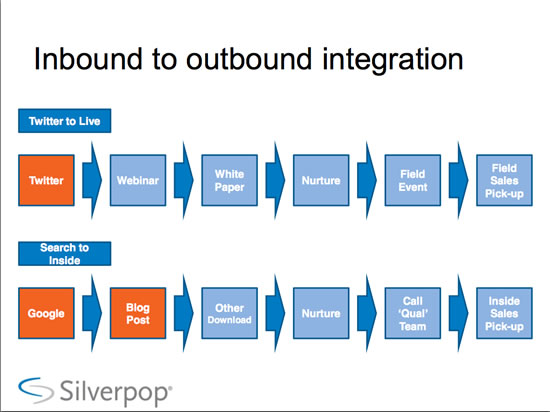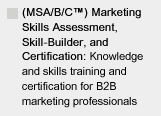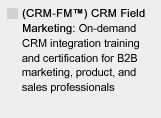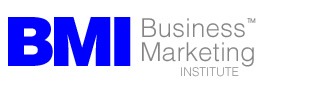MAKE SURE YOU CONTINUE TO RECEIVE EACH ISSUE OF TUESDAY MARKETING NOTES—CLICK HERE TO RENEW YOUR FREE SUBSCRIPTION (IF YOU'VE ALREADY SUBSCRIBED, NO NEED TO RE-SUBSCRIBE)

Six Lessons from B2B University
by Eric Gagnon
Last week, I attended the B2B University event in Washington, DC, a one-day event sponsored by e-mail marketing and lead management system provider Silverpop. This event focused on how B2B marketing professionals can effectively use the tools of marketing automation—e-mail messaging, sales enablement, content management, marketing dashboards, and other specialized elements of these systems to plan, develop, and manage effective online lead generation and lead development (lead nurturing) programs in their companies.
Here are six of the key points that impressed me most from the presentations made at this insightful and informative multi-city event, which I recommend to any B2B marketing professional (click here for the B2B University event schedule) . . .
1.) Your Prospects Are In Charge Now
Adam Needles of Silverpop kicked off the day with the most important big-picture insight, which was repeated by the other presenters: The balance of power has changed from companies who market and sell their products to the potential buyers in their market. Any B2B buyer can now use Google, news and vendor Web sites, and social media to freely search and gather all of the information required for making their initial product and vendor selections, largely bypassing your company’s typical marketing program and “story” as their sole source of their information about your product. This shift places greater emphasis on the importance of developing factual, objective content (see below), and using these new online channels, along with marketing automation, to deliver the right mix and type of information to potential buyers for the appropriate stage of their buying process.
This last point is especially important. As mentioned by several of the presenters in the event, prospects may make their first contact with your company (for example, signing up for a white paper from your company’s Web site), many weeks or months before they’re even ready to have that first phone conversation with your sales company’s sales rep, and this first contact is the beginning of a long series of interactions between prospects and your sales team.
Because of this you’re going to need the systems and content required to guide these prospects over this long sales cycle. As presenter Carlos Hidalgo of The Annuitas Group pointed out, this requires a carefully planned and automated process of lead management to execute, track, and measure this ongoing conversation between your sales team and interested prospects.
2.) Marcom 2.0: It’s All About the Content
An important common thread across all the presentations at B2B University was the critical new role played by content, both in the buyer’s decision-making process, and in the marketing automation systems serving these buyers.
Here, “content” is defined as factual, reasonably objective, and non-promotional information that answers the most likely questions prospects have about your product, and how your product can be used to solve their problem. The form and tone of this content is presented without the usual self-promotion and marketing hype found in most company’s brochures, ads, Web promotions, mailings, or other marketing deliverables those of us in marketing have been accustomed to writing and producing.
In this new environment, where prospects are in charge of the product information they want to see, white papers, case studies, FAQ files, applications videos, fact sheets, e-mail newsletters, product reports, and other content-based deliverables take the lead in your marketing program above the product brochures, print advertising, flyers, press releases, and the other instruments we’ve been using in our marketing programs.
So for marketers, developing the content required for marketing automation systems requires both a re-thinking of the purpose of your messaging to prospects, and a change in the style and approach to writing and developing this content.
3.) Marketing Automation is Smart. It’s the People Who Do Dumb Things With It
There’s still a major disconnect between how marketing automation can be used appropriately to tactfully engage with these prospects in a way that is appropriate to their stage in product and buying process, and the way many companies are using it now.
As Adam Needles of Silverpop pointed out in his presentation, how many times have all of us downloaded a white paper from a Web site, when we were only mildly interested in a product, only to be called the very next day by the sales rep from this company wanting to push us into setting up a day and time for a demo? The other presenters at this event related similar anecdotes of inappropriate and wasteful contacts with prospects using marketing automation to prod hapless sales reps into contacting prospects who were nowhere near being ready to buy.
The point made by more than one of the presenters was that understanding the purchase process from the buyer’s point of view will help you in designing marketing automation processes that appropriately identify when prospects are ready to be engaged by your company at a higher level than “just looking,” and avoid the common mistake of pushing prospects too soon in their product evaluation process.
Another important consideration, addressed at the event by The Annuitas Group’s Carlos Hidalgo, is not to look at the technology itself as the cure-all for addressing this new world where prospects are in control, but to assess your company’s knowledge of its market, and apply this knowledge to a marketing automation process, by establishing procedures, such as lead qualification and lead routing, tied to effective measurement, to make the implementation of your company’s marketing automation system successful.
4.) In B2B, Social Marketing is Much More than Twitter or Facebook
Another important point made by Adam Needles of Silverpop was that most of us tend to focus solely on Twitter, Facebook, and other popular social media sites, without realizing that vertical market and industry-specific discussion forums, blogs, and other interactive spots found outside of these generic social sites are often better channels for social media interaction in B2B markets.
For example, as Adam indicated, popular discussion forums tied to vertical trade news sites in your industry, and comment threads in top blogs in your market are often a more relevant and more productive form of social media, and every bit as important as Twitter or Facebook to serving your goal of reaching potential buyers in your market.
Adding standalone, industry-specific discussion forums, forums, and comment threads tied to industry news sites (as well as comment threads tied to individual articles on these news sites), and comment threads tied to top blogs in your field to your social media “list,” combined with the approach covered in 5.) below, is a useful starting point for developing your company’s own social media marketing strategy.
5.) If You’ve Wondered How to Use Social Media for Lead Generation, Here’s How...
In his “Field Marketing 2.0” presentation, Adam Needles of Silverpop presented this graphic, which for me was a revelation in understanding the role of social media in B2B marketing programs for lead generation:

The key, revealed by Adam’s graphic, is thinking of Twitter, Facebook, or any other online social media venue as just the first step in a process—the first outward contact point with your market, tied to an ongoing series of marketing events and deliverables, each requiring a progressively higher level of time, interest, and involvement from prospects as they become increasingly interested in your product. The revelation here is that social media is only the entry point in a longer conversation that must occur before a browsing, potential interested user becomes a prospect, and is not itself an immediate means to drive prospects directly to your sales team.
This framework also defines the content and tone of the messages you put out on social media. For example, instead of just using Twitter or other social media outlets as an echo chamber for your company’s marketing messages and press releases (as many companies do now), use it instead as the first step in connecting potential buyers to the content, or to announce the free services you offer that solve problems for your prospects. For example, use Twitter, Facebook, and blog posts to announce a new case study created by your company that’s of interest to your market, or provide a link to your Webinar or online event, and then, with the help of marketing automation systems, utilize these connections to your company’s content or services to give participants additional, and progressively deeper, opportunities to engage with your company, by helping these prospects to learn more about your company, its products, and your company’s potential for solving their unique problem.
6.) To Make Your Marketing Program Indispensable, Link Your Marketing Results to Sales and New Business Generation
Mac McIntosh of Acquire B2B provided some useful insights into using these tools of marketing automation to demonstrate to your company’s management just how essential your marketing program is to your company’s sales and growth goals.
Mac gave some especially good pointers on how to present your marketing program’s performance to your company’s CFO, for example, by comparing the lower cost of using marketing automation to contact prospects, compared to the expense of personal sales calls. Here, it’s also important to focus on those big-picture aspects of marketing your company’s CEO and other senior managers pay the most attention to, such as: Cost-per-inquiry, costs for each qualified lead, costs for each lead accepted by sales, and most important—new sales generated, and the percentage of these new sales that can be tracked back to leads generated by your marketing program.
According to Mac, the end result of developing measurable, cost-effective lead generation and lead development programs using marketing automation tools is to reach the point where you can demonstrate that your marketing program is tied to sales as closely as possible. Do this and you can defend attempts to cut your budget by showing your marketing program’s close cause-and-effect linkage to new sales. If you can achieve this, according to Mac, your reply to management’s attempts to cut your marketing budget will then be: “What part of these sales do you want to cut?”
Highly informative and surprisingly free of product pitches, B2B University is one of the most content-rich events I’ve attended on these important topics, and I highly recommend you look into attending an upcoming B2B University event in your area (click here for a link to this event and upcoming event dates).
Eric Gagnon (eric@realmarkets.net), a director with the Business Marketing Institute, is author of The Marketing Manager’s Handbook and The CRM Field Marketing Handbook, and president of GAA ( http://www.realmarkets.net ), an interactive marketing, turnaround, and product development consulting firm.









